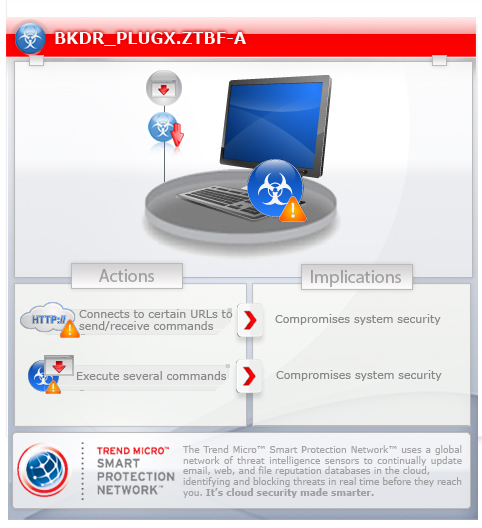BKDR_PLUGX.ZTBF-A
Windows 2000, Windows Server 2003, Windows XP (32-bit, 64-bit), Windows Vista (32-bit, 64-bit), Windows 7 (32-bit, 64-bit)


Threat Type: Backdoor
Destructiveness: No
Encrypted: Yes
In the wild: Yes
OVERVIEW
This malware is part of a targeted attack against certain entities in Taiwan on June 2014, utilizing not only PlugX RAT malware but also the use of Dropbox. It uses Dropbox to update its C&C settings in order to listen and perform commands from a remote malicious user. Users affected by this malware may find the security of their systems compromised.
To get a one-glance comprehensive view of the behavior of this Backdoor, refer to the Threat Diagram shown below.

This backdoor may arrive bundled with malware packages as a malware component.
It executes commands from a remote malicious user, effectively compromising the affected system.
TECHNICAL DETAILS
Arrival Details
This backdoor may arrive bundled with malware packages as a malware component.
Installation
This backdoor drops the following copies of itself into the affected system:
- %All Users Profile%\DRM\RasTls\RasTls.DLL.msc
(Note: %All Users Profile% is the All Users or Common profile folder, which is C:\Documents and Settings\All Users in Windows 2000, XP, and Server 2003, and C:\ProgramData in Windows Vista and 7.)
It drops the following component file(s):
- %All Users Profile%\DRM\RasTls.exe - non-malicious file used to load TROJ_PLUGX.ZTBF-A
- %All Users Profile%\DRM\RasTls.DLL - detected as TROJ_PLUGX.ZTBF-A
- %All Users Profile%\DRM\RasTls\{random file name}
(Note: %All Users Profile% is the All Users or Common profile folder, which is C:\Documents and Settings\All Users in Windows 2000, XP, and Server 2003, and C:\ProgramData in Windows Vista and 7.)
It creates the following folders:
- %All Users Profile%\DRM
(Note: %All Users Profile% is the All Users or Common profile folder, which is C:\Documents and Settings\All Users in Windows 2000, XP, and Server 2003, and C:\ProgramData in Windows Vista and 7.)
It is injected into the following processes running in memory:
- svchost.exe
- msiexec.exe
Autostart Technique
This backdoor registers itself as a system service to ensure its automatic execution at every system startup by adding the following registry entries:
HKEY_LOCAL_MACHINE\SYSTEM\CurrentControlSet\
Services\RasT1s
ImagePath = "%All Users Profile%\DRM\RasTls.exe"
HKEY_LOCAL_MACHINE\SYSTEM\CurrentControlSet\
Services\RasT1s
DisplayName = "RasTls"
HKEY_LOCAL_MACHINE\SYSTEM\CurrentControlSet\
Services\RasT1s
Description = "RasTls"
HKEY_LOCAL_MACHINE\SYSTEM\CurrentControlSet\
Services\RasT1s
ObjectName = "LocalSystem'
HKEY_LOCAL_MACHINE\SYSTEM\CurrentControlSet\
Enum\Root\LEGACY_RAST1S\
0000
Service = "RasT1s"
HKEY_LOCAL_MACHINE\SYSTEM\CurrentControlSet\
Enum\Root\LEGACY_RAST1S\
0000
DeviceDesc = "RasTls"
It registers as a system service to ensure its automatic execution at every system startup by adding the following registry keys:
HKEY_LOCAL_MACHINE\SYSTEM\CurrentControlSet\
Enum\Root\LEGACY_RAST1S
HKEY_LOCAL_MACHINE\SYSTEM\CurrentControlSet\
Services\RasT1s
Backdoor Routine
This backdoor executes the following commands from a remote malicious user:
- Manage files, registries, services and directories
- Log keystrokes and active window
- Restart/Reboot/Shutdown system
- Enumerate processes
- Terminate processes
- Get drive information
- Enumerate network resources
- Set TCP connection state
- Lock workstation
- Display a message box
- Perfrom port mapping
- Capture screen
- Perform remote shell
NOTES:
It connects to the following URL to acquire its C&C setting:
- http://{BLOCKED}.{BLOCKED}xusercontent.com/s/0lkgew1wqqw6h13/20140512.txt
However, as of this writing, the server does not contain the expected file.
This backdoor will only perform its intended routine if the current date is March 5, 2014 or onwards.
SOLUTION
Step 1
Before doing any scans, Windows XP, Windows Vista, and Windows 7 users must disable System Restore to allow full scanning of their computers.
Step 2
Remove the malware/grayware file dropped/downloaded by BKDR_PLUGX.ZTBF-A. (Note: Please skip this step if the threat(s) listed below have already been removed.)
Step 3
Restart in Safe Mode
Step 4
Delete this registry key
Important: Editing the Windows Registry incorrectly can lead to irreversible system malfunction. Please do this step only if you know how or you can ask assistance from your system administrator. Else, check this Microsoft article first before modifying your computer's registry.
- In HKEY_LOCAL_MACHINE\SYSTEM\CurrentControlSet\Enum\Root
- LEGACY_RAST1S
- LEGACY_RAST1S
- In HKEY_LOCAL_MACHINE\SYSTEM\CurrentControlSet\Services
- RasT1s
- RasT1s
Step 5
Search and delete this folder
- %All Users Profile%\DRM
Step 6
Restart in normal mode and scan your computer with your Trend Micro product for files detected as BKDR_PLUGX.ZTBF-A. If the detected files have already been cleaned, deleted, or quarantined by your Trend Micro product, no further step is required. You may opt to simply delete the quarantined files. Please check this Knowledge Base page for more information.
Did this description help? Tell us how we did.
